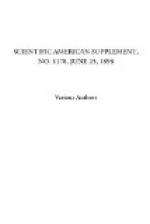A hospital car has been introduced on the Belgian railroads, says The Engineer. It is designed for use in the event of a serious railway accident, and can be run to the spot where the wounded may be picked up and carried to the nearest city for treatment, instead of being left to pass hours in some wayside station while awaiting surgical attendance. The interior of this car is divided into a main compartment, a corridor on one side and two small rooms at the end. The largest compartment, the hospital proper, contains twenty-four isolated beds on steel tubes hung upon powerful springs; each bed is provided with a small movable table, a cord serving to hold all the various small objects which may be needed, and each patient lies in front of two little windows, which may be closed or opened at will. The corridor on the outside of the hospital chamber leads to the linen closet and the doctor’s apartment; in the latter is a large cupboard, the upper portion being used for drugs, while the lower is divided into two sections, one serving as a case for surgical instruments and the other as a receptacle for the doctor’s folding bed.
The dust collected from the smoke of some Liege furnaces, burning coal raised from the neighboring mines, produces, when dissolved in hydrochloric acid, a solution from which considerable quantities of arsenic and several other metallic salts may be precipitated. Commenting on this fact, ascertained by M.A. Jorissen, M. Francis Maur asks whether this breathing of arsenic and other minerals in a finely divided state may not account for the singular immunity from epidemics enjoyed by certain industrial districts, such as that of Saint Etienne, and hopes that some mine doctor will throw additional light on the subject. In the meanwhile, it may be suggested that the ventilating effect of the numerous chimneys in iron making and other industrial centers has its due share in constantly driving off the vitiated air and replacing it by fresh quantities of pure air. At any rate, when pestilence was raging in the high and pleasant quarter of Clifton, its inhabitants migrated to the low-lying and not overclean parish of St. Philips, Bristol, where the air is black from the smoke of numerous chimneys, but where also the mortality compared very favorably with that in the fashionable quarter.
A two-speed movable sidewalk, of the Blot, Guyenet and De Mocomble type, is to be used for conveying visitors at the Paris Exposition, says Engineering News. It differs from those of Chicago and Berlin in the reduction of the weight of the moving platform by spacing the driving wheels 127.5 feet apart and using electricity as a motive power. The driving wheels are mounted in the bed of the track and impart motion to a central rail on the under side of the platform. Bearing wheels, spaced about 20 feet apart under this rail, also carry the platform, and the central rail supports one-half the total weight of the platform;




